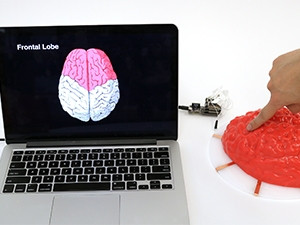
Researchers at the Human-Computer Interaction Institute at Carnegie Mellon University in the US have come up with a way to turn any surface or object into a touch interface.
The technique, called Electrick, can be added to objects using carbon conductive paint, vacuum forming and moulding. This means the ink can be integrated into 3D-printed objects.
It was created by PhD student Yang Zhang, and is not yet available on the market.
In his report, he explains: "Current touch input technologies are best suited for small and flat applications, such as smartphones, tablets and kiosks. In general, they are too expensive to scale to large surfaces, such as walls and furniture, and cannot provide input on objects having irregular and complex geometries, such as tools and toys.
"We introduce Electrick, a low-cost and versatile sensing technique that enables touch input on a wide variety of objects and surfaces, whether small or large, flat or irregular."
He says this is achieved by using electric field tomography in concert with an electrically conductive material, which can be easily and cheaply added to objects and surfaces.
"To track a finger's touch location, electrodes are attached to the periphery of the desired interactive area. A sensor board connected to these electrodes injects an electric field into the conductive substrate, and senses changes in the field's distribution resulting from a user's touch. Sensor data can be transmitted wirelessly, allowing the electronics to be fully contained within an object, eliminating the need for external sensing infrastructure (such as depth cameras)," explains Zhang.
The Future Interfaces Group, the interdisciplinary research lab within the institute at the university, came up with several ways Electrick could be used, including in wearables, smart home technology, 'buttons' inked onto skin and gesture control.
One case study sees playdough being coated and programmed to respond to touch using Electrick. A snowman is modelled and each part of its body is programmed to respond differently when touched.
Another case study highlights a phone case that shows different displays when held in a certain way. For example, the camera app will open when the phone is held with two hands horizontally. The keyboard in a messaging app will open when the case senses the phone is held with one hand vertically.
Share